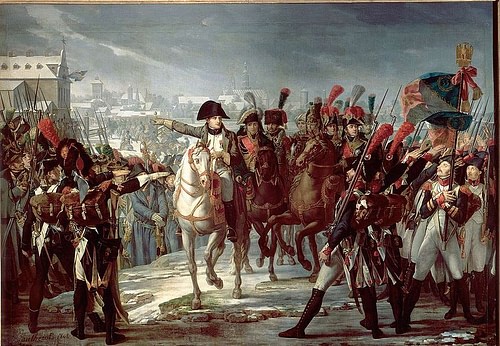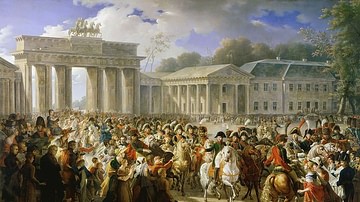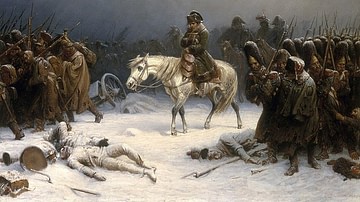The Ulm Campaign (25 September to 20 October 1805) was a military operation during the War of the Third Coalition (1805-1806). Through a series of maneuvers, the 210,000 men of the French Grande Armée, led by Emperor Napoleon I, encircled an Austrian army under General Karl Mack von Leiberich in the city of Ulm. The Austrians capitulated on 20 October.

Background: A New Coalition
In the spring of 1805, the clouds of war were gathering over Europe. Napoleon I had crowned himself Emperor of the French the previous December and had begun to act with increasing impunity and disregard toward the delicate balance of power. In March 1805, he had granted his sister Elisa the principality of Piombino, which had traditionally been a part of the Holy Roman Empire. Two months later, Napoleon donned the Iron Crown of the Lombards, becoming King of Italy in direct violation of the 1801 Treaty of Lunéville, which guaranteed a separation between Italy and France. These actions were tantamount to a slap in the face of Francis II, Holy Roman Emperor, since both Piombino and northern Italy had until recently been in the Austrian sphere of influence; the insult was worsened on 6 June, when Genoa was formally annexed to France.
Russia, too, felt slighted by French imperial ambitions. It had already broken diplomatic ties with France following the controversial execution of the Duke of Enghien in March 1804. Enghien was a Bourbon prince living in exile in Baden, who had been kidnapped and shot after dubious evidence had implicated him in a plot against Napoleon's life. Tsar Alexander I of Russia had protested Enghien's death, seeing it as a blatant disregard for the aristocracies of Europe. At a time when Russia aspired to greater status in Europe, the tsar also felt sidelined by the increasing French influence in Germany and Central Europe. The anxieties of the Russian and Austrian emperors made it easier for them to be swayed by British Prime Minister William Pitt the Younger; the United Kingdom had been at war with France since May 1803, and Pitt was working tirelessly to organize a new anti-French alliance. His efforts paid off when the Third Coalition against France formed in August 1805; the participants included the United Kingdom, Austria, Russia, Naples, Sicily, and Sweden.
The Coalition leaders reviewed what had happened in the French Revolutionary War and were reminded that in the campaigns of both 1796 and 1800, the most decisive battles had taken place in northern Italy. Austrian ministers also emphasized the importance of Italy, hoping to recover their prestige and their lost Italian territories. For these reasons, a 96,000-man army was dispatched to northern Italy under the command of Archduke Charles, a brother of Emperor Francis and arguably Austria's best general.

A second army of 70,000 men was established in Germany, nominally led by another of Francis' brothers, Archduke Ferdinand, but actually under the command of Ferdinand's chief of staff, General Karl Mack von Leiberich. It had been General Mack's report on the readiness of the Austrian army that had convinced Emperor Francis to go to war, causing the emperor to place his trust in Mack for such an important command. At the time, however, none of the Allied commanders knew exactly how important Mack's command would be. With the focus on Archduke Charles in Italy, Ferdinand and Mack were expected merely to invade Bavaria, which had recently allied itself with France, and intimidate the Bavarians into disarming. Then, they would stay put until they could be joined by a 35,000-man Russian army under Field Marshal Mikhail Kutuzov, after which the combined Austro-Russian force would advance to Strasbourg and threaten an invasion of France itself.
With the benefit of hindsight, there were glaring problems with the Allied plan. For one thing, the Allies assumed that Napoleon would prioritize Italy just as he had in 1796 and 1800; this assumption ignored the 210,000-man French army currently mobilizing along the English Channel, which could more easily strike the Allies in Germany. Further, the decision to split the command of the Army of Germany between Archduke Ferdinand and General Mack inevitably led to a clash of personalities, as the archduke and his chief of staff constantly argued. Finally, the eleven-day difference between the Gregorian calendar, used by most of Europe, and the Julian calendar, still used by Russia, would cause much confusion. Tsar Alexander promised that Kutuzov's army would arrive in Bavaria on 20 October, a date that each side interpreted differently. These issues, along with the unexpected energy of Napoleon's Grande Armée, doomed the Third Coalition from the start.
Mack Invades Bavaria
On 8 September, Archduke Ferdinand and General Mack's Austrian army crossed the River Inn, with the intention of establishing a fortified camp around the city of Ulm, which was then part of Bavaria. Though Elector Maximilien-Joseph of Bavaria had thrown his lot in with Napoleon, the Bavarian soldiers did not resist the Austrian advance and withdrew to the northeast. To increase the rapidity of his advance, Mack sought to mimic the French Revolutionary armies he had fought in Flanders, by having his men live off the land. However, unlike the French, the Austrians were unaccustomed to foraging, and the army became scattered as soldiers wandered further away from the main columns in search of food.
Mack reached Ulm by the end of September. Directly on the route between France and Vienna, the Austrian general believed it to be the perfect place for him to keep an eye out for the French while he waited for the Russians. By now, it was apparent that Kutuzov's Russian army was behind schedule, as Kutuzov had only made it to the city of Teschen in Austrian Galicia. The lack of quality roads in eastern Europe had slowed the Russian advance, and although the Austrians had provided the Russians with carts at Teschen to hurry them along, it was clear that it would still be a long time before they set foot on Bavarian soil. But Mack was not worried. He calculated that the Russians would arrive in Germany within 64 days and believed that it would take the French 68 days to reach Bavaria. What Mack could not have known was that the French had already been on the march for a week.
March of the Grande Armée
"Austria appears to want war," Napoleon wrote to Elector Maximilien-Joseph of Bavaria on 25 August. "I cannot account for such erratic behavior; however, she will have it, and sooner than she expects" (Roberts, 366). Since the resumption of Anglo-French hostilities in May 1803, Napoleon had gathered a vast army at the camp of Boulogne, poised for an invasion of England. Although the circumstances for such an invasion never arose, the so-called Army of England had spent the intervening months training and was already mobilized in the summer of 1805. After sending Marshal André Masséna and 68,000 men into Italy to distract Archduke Charles' Austrians, Napoleon issued orders for his 210,000-man Army of England – soon to be rechristened as La Grande Armée – to march to the Rhine.

The French moved remarkably fast, with some units covering 32 kilometers (20 mi) a day. Part of the reason for the Grande Armée's efficiency was the corps d'armée system, which broke the army down into seven distinct corps. Each corps was essentially an army on its own, consisting of infantry, cavalry, and artillery units and commanded by a marshal or general. The corps marched separately from one another, thereby allowing the French to cover more ground, though they usually remained close enough to rush to each other's aid in the event of an engagement with enemy troops. While each corps enjoyed a degree of autonomy, ultimate authority over the entire army rested in the hands of the emperor, which gave the command of the Grande Armée a sense of cohesiveness that the Austrians did not have. By 1805, the corps system was nothing new – Napoleon had ordered every French army to implement it prior to the Battle of Marengo in 1800 – but the Ulm campaign would be a masterclass in how to utilize such a system effectively. Below is a list of the corps of the Grande Armée during the Ulm Campaign:
- I Corps: Marshal Jean Bernadotte, 17,000 men
- II Corps: General Auguste de Marmont, 20,000 men
- III Corps: Marshal Louis-Nicolas Davout, 26,000 men
- IV Corps: Marshal Jean-de-Dieu Soult, 40,000 men
- V Corps: Marshal Jean Lannes, 18,000 men
- VI Corps: Marshal Michel Ney, 24,000 men
- VII Corps: Marshal Charles-Pierre Augereau, 14,000 men
- Cavalry Reserve: Marshal Joachim Murat, 22,000 cavalrymen
- Imperial Guard: Marshal Jean-Baptiste Bessières, 7,000 men
Marching on routes parallel to one another, the corps arrived on the banks of the Rhine on 25 September and immediately crossed it, marching for the Danube. Daily marches usually began at around 4 or 5 in the morning and lasted until around noon, allowing the French soldiers the remainder of the afternoon to rest and forage for food. Despite wet and cold weather conditions, the men were generally in good spirits, singing songs and making jokes – the men joked that the emperor was creating a new weapon out of their legs to replace bayonets. Often, Napoleon arranged for local authorities to have provisions laid out for the corps before their arrival, an advantage of the German allies that the emperor had cultivated. In fact, during the march into Germany, Napoleon visited the rulers of Baden and Württemberg to finalize alliances; the emperor guaranteed their independence in return for political and military support. As the Grande Armée advanced into Bavaria, they were joined by 25,000 Bavarian troops.
The French Cross the Danube
Upon reaching the Rhine, Napoleon sent Marshal Lannes' V Corps and part of Murat's Cavalry Reserve into the Black Forest to distract Mack and keep Austrian eyes focused on the west. On 2 October, the rest of the army began to wheel south toward the Danube, a maneuver that historian David Chandler likens to "a door swinging on its hinges" (392). By now, Mack was aware that the French were approaching, but he had no idea how large their army was; the dense woods of the Black Forest and the line of the Jura Mountains concealed the French numbers from the Austrian scouts. By contrast, Napoleon was well apprised of the Austrians' numbers and movements, having sent spies into the Austrian camp. With the information he gathered, Napoleon planned to turn Mack's flank and attack him in the rear, thereby trapping the Austrians in Ulm and cutting them off from any reinforcements.
On 7 October, the Grande Armée reached the Danube, only twelve days after crossing the Rhine. The next day, Murat and Lannes made first contact with the enemy, encountering an isolated Austrian detachment at Wertingen. The Austrians were decimated in the subsequent battle, and the French took 2,900 men prisoner. On 9 October, the other six corps secured key bridges across the Danube and began to cross the river. Most of the corps crossed unopposed, but Marshal Ney's VI Corps encountered heavy resistance as it tried to force the crossing at Günzburg. After suffering 2,000 casualties, the Austrians pulled back from Günzburg and retreated into Ulm. With his army now across the Danube, Napoleon began the encirclement of Ulm; the I and III Corps, along with the 25,000 Bavarians, were sent to Munich to set up a 'zone of security' and watch for the approaching Russians. Meanwhile, Marshal Soult's IV Corps marched to Memmingen, due south of Ulm, Marmont's II Corps marched in a narrower arc to support Soult's right, and the V and VI Corps moved due west of the city. Each corps was within 48 hours' supporting distance of at least two of its neighbors.
In Ulm, Mack's officers urged him to break out of the encirclement before it was complete. He agreed, and on 11 October he led 23,000 men to look for a route of retreat down the north bank of the Danube. Between the towns of Haslach and Jungingen, these Austrians ran into a lone French division of 4,000 men commanded by General Pierre Dupont. Realizing the presence of Austrian cavalry denied him a safe retreat, Dupont elected to hold his ground; the Battle of Haslach lasted throughout the day and resulted in heavy casualties on both sides. Dupont managed to hold out until nightfall, then he withdrew. Mack, who had led the Austrians personally, sustained a light wound and pulled his men back to Ulm.
The Noose Tightens
It was at this point that Mack should have kept attacking the French, delaying the completion of their encirclement of Ulm, and buying time for the Russians to arrive. Instead, he did nothing. Napoleon had planted 'deserters' who, after deliberately being captured, told the Austrians that the British had landed at Boulogne and that the army was about to return to France to deal with them. This was a lie, of course, but Mack had no way of knowing this. As he waited for the French to leave, relations between him and his staff continued to deteriorate; by now, Archduke Ferdinand and Mack were not on speaking terms, and only communicated with one another by letter.

By 14 October, Mack realized he had been deceived and finally decided to do something. He sent two corps along the north bank of the Danube to search for a route of retreat. The first Austrian corps, under General Johann Sigismund Riesch, headed toward Elchingen to secure a bridge there. His corps was intercepted by Ney, leading to several hours of brutal fighting around the hill town of Elchingen. Riesch was defeated and after leaving some 2,000 Austrians dead and wounded on the battlefield and another 4,000 captured, he withdrew back to Ulm; for this victory, Ney was later made the Duke of Elchingen. The second Austrian corps, under General Franz von Werneck, continued marching north, though it was closely pursued by Murat's cavalry.
The Austrian defeat at Elchingen sent Mack into a state of despair. It was also the last straw for Archduke Ferdinand, who, tired of Mack's leadership, led 6,000 cavalry out of Ulm with the intention of linking up with Werneck. Ferdinand left not a moment too soon, since by the next morning, Napoleon's encirclement of Ulm was complete. Soult had seized his objective of Memmingen after swatting aside minimal Austrian resistance, Marmont and the Imperial Guard had taken position on the southern outskirts of the city, and Ney had successfully stormed the Austrian encampments on the heights of Michelsberg, which offered an excellent position from which to bombard the city.
Mack Surrenders
At 3 a.m. on 17 October, as Ney was busy setting up his artillery batteries, Napoleon sent his emissary, Comte de Ségur, to meet with Mack. The Austrian army was, by now, demoralized and low on ammunition, but Mack was convinced that the Russians must be close. For this reason, Mack agreed to surrender on 25 October, but only if no reinforcements had arrived before then. Ségur agreed because, unlike Mack, he knew that Kutuzov's Russians were still 290 kilometers (180 mi) away and could not possibly arrive by the 25th. In the end, the French did not even have to wait that long. On 18 October, Murat finally caught up with General Werneck's corps at Trochtelfingen and forced him to surrender; Archduke Ferdinand changed course and led his cavalry into Bohemia. Werneck's defeat demoralized the army further, and, on the 19th, Mack agreed to surrender the next day.

On 20 October, Napoleon stood on the heights of Michelsberg, his back to a great bonfire, as 25,000 defeated Austrians filed past him. The Austrian soldiers piled their weapons and colors at the foot of the heights as Mack approached Napoleon and introduced himself with the words, "Sire, here is the unhappy General Mack" (Chandler, 400). Along with the surrendered Austrian soldiers, the French also captured 60 guns. Mack and the other officers were permitted to leave after they had signed a parole, promising not to take up arms against France until they had been exchanged. Upon returning to Vienna, Mack was convicted of cowardice by a court-martial; he was stripped of his rank and spent two years imprisoned.
The Ulm campaign had been a great victory for the French; as Napoleon put it in his post-battle bulletin, "Never have victories been so complete and less costly" (Chandler, 402). With the capitulation of Ulm, the Austrian Army of Germany ceased to exist, and the road to Vienna was left wide open; on 12 November, Napoleon captured the Austrian capital, and on 2 December, he decisively defeated the Austrian and Russian armies at the Battle of Austerlitz, securing victory in the War of the Third Coalition. Yet Napoleon's continental victories were offset by a defeat on the waves; on 21 October, only a day after the surrender of Ulm, Admiral Villeneuve's Franco-Spanish fleet was obliterated by Lord Nelson's British ships at the Battle of Trafalgar.
Conclusion

The Ulm Campaign has long been regarded as a brilliant display of military maneuvering and set the example for the military tactics of 'turning movement'. It highlighted the importance of the corps system, which would become the basic building block of armies during the 19th and 20th centuries. Napoleon's Ulm campaign would be studied by tacticians and influenced the development of future military plans, including the Schlieffen plan, which was the German war plan to invade France prior to World War I.









